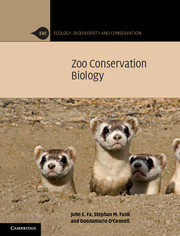Book contents
- Frontmatter
- Contents
- Foreword
- Preface
- Acknowledgements
- 1 Biodiversity and zoo conservation biology
- 2 Protecting species and habitats
- 3 Zoos in focus – public exhibition or conservation
- 4 Keeping animals in captivity
- 5 Viable captive populations – the numbers game
- 6 Captive breeding and zoos
- 7 Returning animals to the wild
- 8 Educating the public
- 9 Turning zoos into conservation centres
- Appendix 1 Commonly used abbreviations
- Appendix 2 Scientific names of species mentioned in the text
- Appendix 3 Inbreeding
- Appendix 4 Population sizes – definitions and implications
- Appendix 5 Captive breeding and genetics – definitions
- References
- Index
- Plate section
7 - Returning animals to the wild
Published online by Cambridge University Press: 05 August 2012
- Frontmatter
- Contents
- Foreword
- Preface
- Acknowledgements
- 1 Biodiversity and zoo conservation biology
- 2 Protecting species and habitats
- 3 Zoos in focus – public exhibition or conservation
- 4 Keeping animals in captivity
- 5 Viable captive populations – the numbers game
- 6 Captive breeding and zoos
- 7 Returning animals to the wild
- 8 Educating the public
- 9 Turning zoos into conservation centres
- Appendix 1 Commonly used abbreviations
- Appendix 2 Scientific names of species mentioned in the text
- Appendix 3 Inbreeding
- Appendix 4 Population sizes – definitions and implications
- Appendix 5 Captive breeding and genetics – definitions
- References
- Index
- Plate section
Summary
‘Researchers contemplating future reintroductions [should] carefully evaluate a priori the specific goals, overall ecological purpose, and inherent technical and biological limitations of a given reintroduction…’
(Phillip Seddon)Introduction
The intentional movement by humans of an animal or a population of animals from one location with free release at another to re-establish a species which has been lost, or supplement existing populations, has become an important tool in conservation biology (Fischer & Lindenmayer, 2000; Seddon et al., 2007). A common goal of many animal translocations is the establishment of self-sustaining populations. Animals may be sourced from other wild populations or from captive-stock. From an ecological perspective, the implications of where the animals originate, and therefore how prepared they may be for independent life post-release, and whether release site habitats are able to support viable populations, needs assessment. Re-establishment of species in areas from which they have been extirpated has never been intended to be the only means to conserve biodiversity. But, this is a particularly useful approach that is likely to be used increasingly in the coming decades, as numbers of critically endangered species rise (Chapter 3), or as some advocate if assisted colonisation of species (also referred to as managed relocation, assisted migration, or assisted translocation) becomes a realistic intervention strategy in biodiversity management under climate change (Hoegh-Guldberg et al., 2008).
- Type
- Chapter
- Information
- Zoo Conservation Biology , pp. 190 - 219Publisher: Cambridge University PressPrint publication year: 2011



